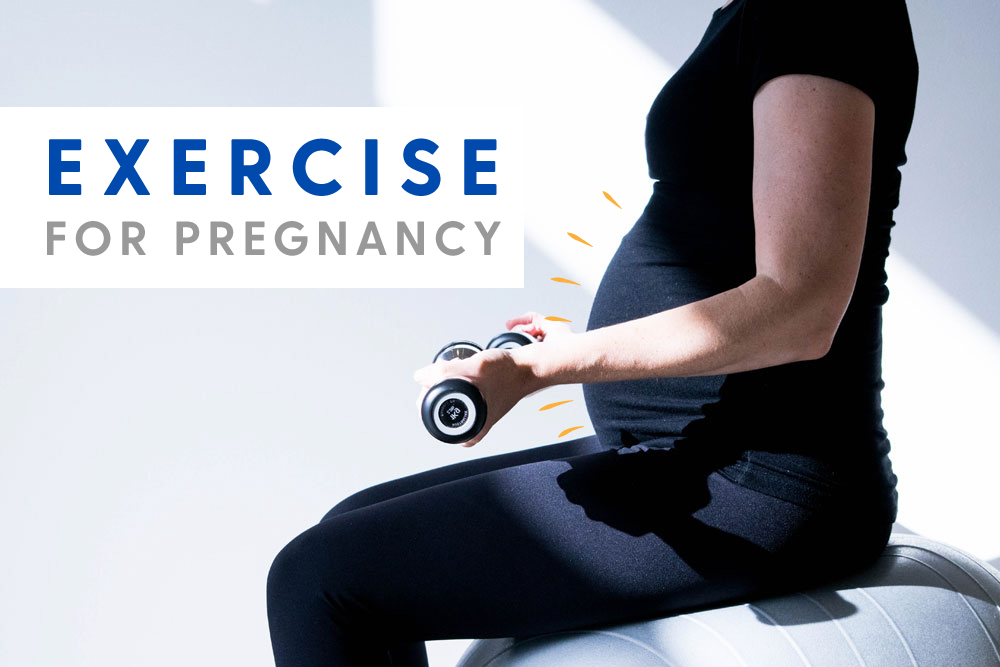
Exercise during pregnancy

Regular physical activity during pregnancy can offer a wide range of benefits for women who have been previously active as well as for those who have led a sedentary lifestyle.
Prior to commencing an exercise program, speak with your general practitioner, midwife or obstetrician to make sure that you do not have any health concerns which would prevent you from participating in a regular exercise program during your pregnancy.
Frequency: How often should you exercise?
In a healthy pregnancy, aim to complete some form of physical activity on most, preferably all, days of the week. If you were previously inactive, start by exercising 3 to 4 days per week, allowing for a recovery day between sessions.
Muscle strengthening or resistance exercises should also be performed on at least two days per week, however pregnant women need to ensure that normal breathing is maintained during the exercise. Currently, there is no evidence to suggest that regular exercise during an uncomplicated pregnancy is detrimental to the pregnant woman or baby.
Duration: How long should you exercise for?
Healthy pregnant women should aim to complete 150-300 minutes of moderate intensity physical activity every week – only 30 minutes on 5 days a week! Currently, there is no evidence outlining the upper limit of exercise duration, however it is not recommended to extend an exercise session past 60 minutes duration.
Previously inactive women, or those who are overweight, can start with shorter sessions (15-20 minutes) and then slowly increase up to 30 consecutive minutes.
Intensity: How ‘hard’ should you exercise?
The intensity of the exercise will depend on your baseline level of fitness and previous exercise routine.
If you were regularly completing moderate-intensity exercise before pregnancy, you can aim to maintain a similar level of intensity during pregnancy, paying attention to how comfortable you feel during exercise as the pregnancy progresses. Being aware of how your body is feeling, and adjusting your exercise as you can, ensures that you will feel safe when completing an exercise program. Special attention should also be paid to ensuring adequate nutrition and hydration are maintained and that you avoid overheating while exercising.
How can I measure intensity during exercises?
The intensity of any exercise can be monitored based on your heart rate response to exercise, and/or rating of perceived exertion – that is, how hard you feel you are exercising.
Pregnancy-specific heart rate zones equivalent to 60-80% of max heart rate have been recommended for normal-weight pregnant women. Previously inactive women may aim to exercise in the lower end of these zones, while those accustomed to regular exercise may aim to achieve a heart rate at the upper end of these zones.
Previously inactive, or overweight women with lower base fitness levels, may aim for heart rate zones of 102-124 beats per minute (for women aged 20-29 years), or 101 – 120 beats per minutes (for women aged 30-39 years).
If you don’t have access to an accurate heart rate monitor, a more practical way to monitor the intensity of your exercise program is the rating of perceived exertion (RPE), which can be used in combination with heart rate monitoring, or RPE alone. A rating of 12-14 on a Borg scale (that has a range 6-20) reflects exercise of a moderate intensity. For those women with a higher level of fitness that are accustomed to regular vigorous exercise, a rating 15-16 may be appropriate.
| Description of Exertion | Borg Rating of Perceived Exertion | Example |
| Light | 11 to 12 | Slow walks |
| Somewhat hard | 13 to 14 | Brisk walking – increase your heart rate but doesn’t leave you out of breath |
| Hard | 15 to 16 | Cycling, swimming – increase heart rate significantly and make you breathe very fast |
Another simple way of gauging the intensity of an exercise program is the “talk test” – if you can comfortably hold a conversation, you are likely to be exercising at a moderate level, but if you have to pause to catch your breath, the exercise intensity is likely to be considered vigorous.
Mode: The type of exercise
Pelvic floor! Just kidding. While pelvic floor exercises are very important, and should be completed regularly, pregnant women are encouraged to participate in both aerobic (cardiovascular) exercise and strengthening (resistance exercises). Great aerobic exercises to try include walking (brisk pace), stationary cycling or swimming, as they are continuous activities that use large muscle groups and elevate the heart and breathing rate (feeling that ‘huff and puff’).
Strengthening (resistance) exercises can be performed using light weights, body weight or resistance-bands. Aim for two sessions of resistance exercises per week, on non-consecutive days (to allow for rest and recovery). Pregnant women are encouraged to perform exercises that cover the main muscle groups of the body (legs and arms!), performing 1-2 sets of 12-15 repetitions of each exercises. Movements should be controlled and performed with proper breathing technique (using your exhale on exertion, and avoid holding your breath). Exercises should be performed seated or standing where possible, particularly after the first trimester.
Always seek the guidance of an exercise professional such as an Accredited Exercise Physiologist or physiotherapist to assist you with maintaining a safe level of exercise throughout your pregnancy.
